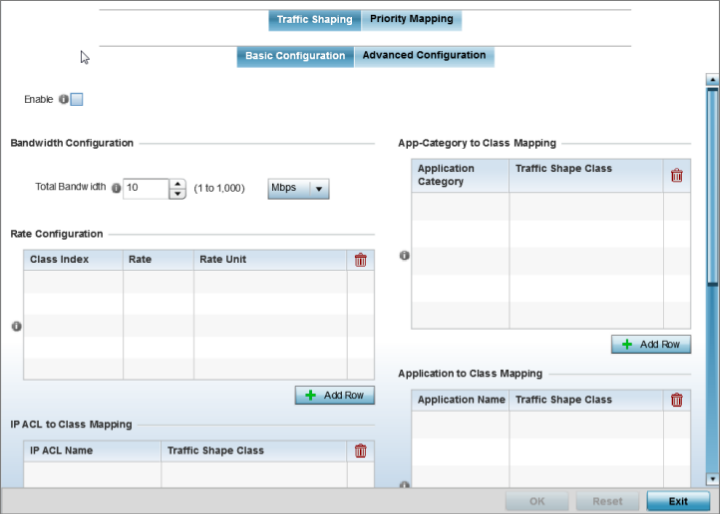QoS Traffic Shaping Basic
Configuration
The WiNG software uses
different Quality of Service (QoS) screens to define WLAN and
device radio QoS configurations. The is separate from WLAN and radio QoS
configurations, and is used to configure the priority of the
different DSCP packet types.
QoS values are required to provide service priority to packets. For example, VoIP
packets get higher priority than data packets to provide a better quality of service
for high priority voice traffic.
The profile QoS screen maps the 6-bit Differentiated Service Code Point (DSCP) code
points to the older 3-bit IP Precedent field located in the Type of Service byte of
an IP header. DSCP is a protocol for specifying and controlling network traffic by
class so that certain traffic types get precedence. DSCP specifies a specific
per-hop behavior that is applied to a packet.
To define an QoS configuration for DSCP mappings:
-
Go to .
-
Expand Network and
select Quality of
Service (QoS).
The screen displays by default.
QoS - Traffic Shaping
- Basic Configuration Screen
-
Select Enable to provide
traffic shaping using the defined bandwidth, rate and class mappings.
Apply traffic shaping to specific applications to apply application
categories. When application and ACL rules are conflicting, applications
have priority, followed by application categories, then ACLs.
-
Set the Total Bandwidth
configurable for the traffic shaper. Set the value from either 1 - 1,000 Mbps,
or from 250 - 1,000,000 Kbps.
-
Select + Add Row within
the Rate
Configuration table to set the Class Index (1 - 4) and Rate (in
either Kbps, Mbps or percentage) for the traffic shaper class. Use the rate
configuration to control the maximum traffic rate sent or received on the
device. Consider this form of rate limiting on interfaces at the edge of a
network to limit traffic into or out of the network. Traffic within the set
limit is sent and traffic exceeding the set limit is dropped or sent with a
different priority.
-
Refer to the IP ACL Class
Mapping table and select + Add Row to
apply an IPv4 formatted ACL to the shaper class mapping. Select + Add Row to add
mappings.
-
Refer to the IPv6 ACL Class
Mapping table and select + Add Row to
apply an IPv6 formatted ACL to the shaper class mapping. Select + Add Row to add
mappings.
-
Refer to the App-Category to Class
Mapping table and select + Add Row to apply an application
category to shaper class mapping. Select + Add Row to add mappings by selecting
the application category and its traffic shaper class. For more information on
creating an application category, refer to Application.
-
Refer to the Application to Class
Mapping table and select + Add Row to apply an application to
shaper class mapping. Select + Add Row to add
mappings by selecting the application and its traffic shaper class. For more
information on creating an application, refer to Application.
-
Select the OK button to save
the traffic shaping basic configuration changes.
Select Reset to revert to the last saved configuration.

